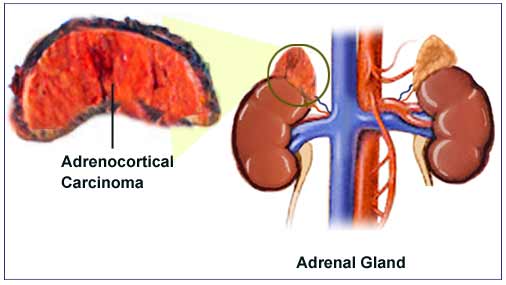How are adrenal cortical cancers staged?
In addition to diagnosing adrenal cortical cancers, the radiographic imaging performed also helps to determine the stage of the patient. According to the seventh edition of the American Joint Committee on Cancer (AJCC), which defines cancer staging systems, patients with adrenal cortical cancer are divided into one of four stages. Please note that there is no AJCC staging system for medullary adrenal carcinoma.
 Stage I: The cancer is smaller than 5 cm and has not spread outside of the adrenal gland.
Stage I: The cancer is smaller than 5 cm and has not spread outside of the adrenal gland.
Stage II: The cancer is larger than 5 cm and has not spread outside of the adrenal gland.
Stage III: The cancer has spread into the fat surrounding the adrenal gland or has spread to lymph nodes or other organs near the adrenal gland.
Stage IV: The cancer has spread to other parts of the body.
How are adrenal adenomas treated?
Most adrenal adenomas are detected on a CT scan or MRI scan that is performed for an unrelated reason. It is only necessary to treat them if they are causing symptoms. Otherwise, they can be followed with repeated scans periodically. In the event that an adenoma does need to be treated, surgical removal is the most frequent treatment used. In many cases, this can be performed using a laparoscopic procedure. A laparoscope is a small fiberoptic camera that can be inserted into the abdomen through small incisions. Other small instruments can also be inserted through these incisions. The adrenal adenoma can be resected while inside the body, without making a large incision in the abdomen, and removed through the small holes through which the camera and other instruments are inserted. Occasionally, because of the size or location of the adenoma, a laparoscopic procedure cannot be performed, and a large incision will need to be made in the abdomen in order to remove the tumor.
In the majority of cases of hyperaldosteronism, symptoms resolve with surgical removal of the adenoma; however, 30% of patients will have repeat episodes of high blood pressure even after the adenoma is removed. If the adrenal adenoma produces cortisol, the patient should take steroids by mouth before and for some time after the surgery until the body is able to produce these steroids on its own again.
How are adrenal cortical cancers treated?
Surgery
Currently, the only known way to cure adrenal cortical cancers is complete surgical removal of the tumor. Unfortunately, this is only possible for some patients with this disease. At least half of patients with adrenal cortical cancers have metastases or cancer invading into other organs, so that complete removal of the tumor is not possible. The best results with surgical resection have been with an en bloc resection, meaning that the entire tumor is removed in one piece. This also includes removing the entire kidney on the same side as the adrenal cancer. Because of this, it is unusual for adrenal cancers to be removed using a laparoscopic procedure, although as techniques of laparoscopic resection improve, more patients are being treated with this method. Occasionally, adrenal cancers will grow into the large blood vessel that carries blood back from the lower body to the heart (the vena cava). Even in these cases, complete removal of the cancer can sometimes be performed, but will require input from a general surgeon, an urologist, and a vascular surgeon.
Even in cases where the tumor cannot be removed in its entirety, surgical removal of as much tumor as possible can improve symptoms, particularly if they are due to excessive steroid secretion.
Chemotherapy
Chemotherapy refers to a group of medications that are given intravenously or orally as a pill. These drugs travel throughout the body to kill cancer cells. This is one of the big advantages of chemotherapy. If cancer cells have broken off from the tumor and are somewhere else inside the body, chemotherapy has the chance of killing them. A number of different chemotherapeutic agents exist, each with its own side effects. You should discuss the potential side effects of any chemotherapy you may receive with your medical oncologist.
The most common chemotherapy used in treatment of adrenal cortical cancers is mitotane. Mitotane acts to block the hormones produced by the cancer and can also kill adrenal cancer cells. Mitotane or other chemotherapy is almost always used when surgery is not possible, or if surgery is done, but some tumor remains in the body. In many cases, Mitotane is also used for patients after surgery even if every visible cancer cell has been removed. Streptozosin is a second chemotherapy drug that has been shown to work in combination with mitotane. Mitotane with or without streptozosin has been shown in clinical trial to reduce the risk of adrenal cortical cancers growing back after they are removed surgically. Even if cancers cannot be removed surgically because they have spread to other parts of the body, mitotane may cause tumors to shrink and reduce symptoms.
Exactly which chemotherapeutic agents are given varies according to the physician giving them. Based on your own health status and the risks of side effects that you are willing to accept, the choice of chemotherapy can vary.


